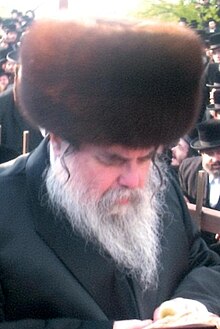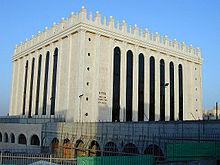Belz (Hasidic dynasty)
While Aharon managed to escape Europe, together with his brother Rabbi Mordechai Rokeach, most of the Belz Hasidim were murdered in the Holocaust.Dedicated in 1843, the building resembled an ancient fortress, with 3-foot-thick (0.91 m) walls, a castellated roof and battlements adorned with gilded balls, and could seat 5,000 worshippers.The Rebbe, his brother, and his attendant, shorn of their distinctive beards and payot (sidelocks), were disguised as Russian generals who had been captured at the front and were being taken to Budapest for questioning.[1] Rebbe Aharon and Rabbi Mordechai spent eight months in Budapest, before receiving highly rationed Jewish Agency certificates to enter Palestine.Belz, like Ger and Satmar, was comparatively fortunate in that its leadership remained intact and survived the war, as opposed to many other Hasidic groups which suffered losses both in terms of rank-and-file supporters, as well as the murder of their leaders.He laid the groundwork for the spread of Belzer Hasidism through the establishment of schools and yeshivas in Tel Aviv, Bnei Brak, and Jerusalem.His sights set on expanding Belz, he drew up plans for a large yeshiva and study hall in downtown Jerusalem, on a hill behind the original Shaarei Tzedek Hospital.Yissachar Dov married at the age of 18 to the daughter of the Vizhnitzer Rebbe, Rabbi Moshe Yehoshua Hager, and moved to Bnei Brak to be close to his new father-in-law.Since 1966, Rabbi Yissachar Dov Rokeach has presided over both the expansion of Belz educational institutions and the growth of Hasidic populations in Israel, the United States, Canada, and Europe.In December 2015, Belz bought a half-acre property in West Brighton, Staten Island, for $1.8 million, to develop a new Yeshiva Ketana complex.





Shalom RokeachYiddishHasidicdynastyUkrainePolishCrown of the Kingdom of PolandYehoshua RokeachYissachar DovAharoninvasion of PolandHolocaustYissachar Dov RokeachsynagogueAharon Rokeachinvasion of Poland (1939)Nazi GermanyGeneral GovernmentBug riverGestapoextraditionexterminationNazi occupation of PolandMordechai of BilgorayPremishlanKraków GhettoBochniacounter-intelligenceBudapestJewish AgencyOrient ExpressIstanbulGrand Rabbi Yissachar Dov RokeachTel AvivSatmarHaredi JudaismBnei BrakKatamonShaarei Tzedek HospitalVizhnitzerAharon Mordechai RokeachBelz Great SynagogueJerusalemLondonStamford HillCommercial RoadLimehouseEast EndThird Belzer Rebbe, Yissachar Dov RokeachEast Side ManhattanBorough Park neighborhoodBrooklynrabbisVizhnitzNew York metropolitan areasynagoguesWilliamsburgStaten IslandMonsey, New YorkSpring Valley, New YorkLakewood, New JerseyCatskill MountainsSaratoga SpringsVal-Morin, QuebecLos AngelesMontrealQuebecWest BrightonBill de BlasioBeis HaMedrash HaGadolTorah scrollsSeer of LublinElimelech LipmanDovberBaal Shem Tovyeshivasyeshiva gedolasAshdodBeitaryeshiva ketanasTelzstoneBeit HilkiaKomemiyutAntwerpMonseyBorough Park, BrooklynYaakov Yechezkiya GreenwaldShulem LemmerYaakov Yitzhak NeumannMordechai RokeachFaigy MayerYisrael EichlerHasidic Judaism in PolandHistory of the Jews in PolandHistory of the Jews in Galicia (Central Europe)History of the Jews in UkraineMishpachaWayback MachineHasidic dynastiesPolandAlexanderAmshinovAshlagChentshinGrodzhiskIzhbitzaKozhnitzKuzmirLublinModzitzNovominskOzharovPorisovPeshischaRadomskRadoshitzRadzinRadzyminSochatchovZychlinGaliciaBurshtinChortkovHusiatynKomarnoKopyczynitz
